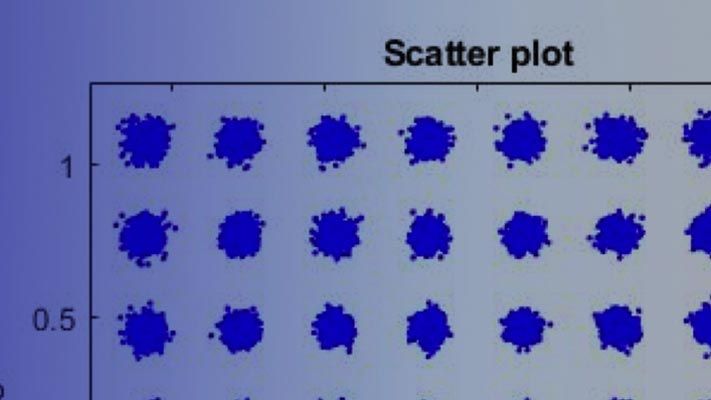Leading wireless engineering teams use MATLAB® and Simulink® to develop 5G new radio access technologies, including flexible physical layer architectures, massive MIMO antenna arrays, and highly integrated RF transceivers. They use MATLAB to:
- Create and optimize IP for 5G products
- Simulate the impact of algorithm, RF, and antenna design choices on system performance
- Ensure designs are standard-compliant
- Verify the behavior of designs with hardware prototypes and over-the-air tests
- Share models and code across development teams
Using MATLAB for Wireless Design
How MATLAB and Simulink Accelerate 5G Development Tasks
End-to-end link simulation
Develop and optimize your 5G physical layer design using standard-compliant models. Evaluate the impact of algorithm and array design choices, RF impairments, and sub-6GHz and mmWave propagation channels.

Figure 1. Evaluate the performance impact of 5G algorithm design with end-to-end uplink or downlink simulation.
Learn More
- Downlink Carrier Waveform Generation - Example
- Transmission Over MIMO Channel Model - Example
- 5G New Radio Polar Coding - Example
- NR Synchronization Procedures - Example
- 5G NR Uplink Throughput Simulation - Example
Related Products
5G-compliant waveform generation and testing
Generate 5G-compliant waveforms and automate testing of simulations and over the air transmissions. Use RF instruments and software-defined radio hardware to transmit 5G waveforms and capture live RF signals. Analyze and visualize simulation, laboratory, and field test results.

Figure 2. Time-frequency visualization of a 5G-compliant downlink waveform.
Learn More
- Downlink Carrier Waveform Generation - Example
- SINR Map for a 5G Urban Macro-Cell Test Environment - Example
- 5G NR Uplink Carrier Waveform Generation - Example
- Understanding 5G Beam Management - White Paper
Related Products
RF system engineering for mmWave and massive MIMO
5G operation at mmWave frequencies requires new hybrid radio architectures to overcome higher propagation losses and channel impairments. Use MATLAB and Simulink to jointly model and simulate the digital, RF, and antenna subsystems, including wideband power amplifiers, massive MIMO antenna arrays, and adaptive algorithms. Multidomain simulation enables more thorough design validation before testing in the hardware lab or field trials. Component engineers can share models and collaborate more easily using a single tool.

Figure 3. Beam pattern for a massive MIMO antenna array.
Learn More
- Model RF Power Amplifiers and Increase Transmitter Linearity with DPD Using MATLAB - White Paper
- Power Amplifier Modeling and DPD Design with MATLAB (3:15) - Video
- Massive MIMO/Hybrid Beamforming - Example
- Exploring Hybrid Beamforming Architectures for 5G Systems - White Paper
- 5G Phased Array Technologies - eBook
- 5G Beamforming Design (38:29) - Video
- Understanding 5G Beam Management - White Paper
- What Is Massive MIMO? (3:25) - Video
Related Products
Model-Based Design for prototyping and verification
Using Model-Based Design with MATLAB and Simulink enables system modeling and development workflows to accelerate 5G hardware and software implementation. You can make design changes at a high level and automatically generate code and testbenches.
Model-Based Design enables you to experiment with different architectures and algorithms, iteratively adjust parameters, predict hardware performance, and automate prototyping on SDRs and other FPGA or SoC hardware.
Figure 4. Model-Based Design for 5G system development with MATLAB and Simulink.
Learn More
- 5G NR HDL Cell Search and MIB Recovery Reference Application (7:15)
- How to Generate a 5G Waveform for SystemVerilog Verification Using 5G Toolbox (5:45)
- Deploying 5G NR Wireless Communications on FPGAs: A Complete MATLAB and Simulink Workflow - White Paper
- Taking Wireless Infrastructure Systems Design from 3G to 5G and Beyond - White Paper
How Are bat365 Customers Developing These Technologies?
Qualcomm
“We use MATLAB models to optimize and verify the 5G RF front end through all phases of development.”
Sean Lynch, Qualcomm UK Ltd.
Nokia
“Working with bat365 has enabled Nokia to establish Model-Based Design, which has brought flexibility, visibility, and capability to react through entire 5G DFE design flow by providing greater understanding of options, faster execution, and quality improvements.”
Sami Repo, Nokia
Convida Wireless
“MATLAB made it easy for us to prototype 5G features because we could start with validated transmitter functions, customize them with our own enhancements, and rapidly produce a prototype for simulation.”
Allan Yingming Tsai, Convida Wireless
Lekha Wireless
“With MATLAB and 5G Toolbox we can perform unit-level functional verification and performance validation of our signal chains long before RF testing. When engineers deliver to the integration branch, we know the modules are fully qualified before we perform end-to-end tests.”
Gurucharan Acharya, Lekha Wireless Solutions


